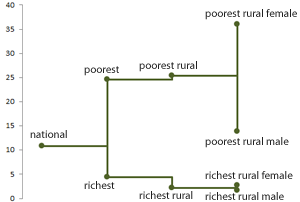
8 Mar, 2012
Rural Women Miss Out on Education and Decent Jobs
The theme of this year’s International Women’s Day on March 8, “Empower Rural Women,” sheds light on the struggle that many poor, rural women face in completing even the most basic education — a finding that is backed up by new data analysis by the Education for All Global Monitoring Report team.

Percentage of Kenyan 17-22 year olds with less than four years of schooling, 2009
This is true even for countries that have made strong progress in expanding access to primary education. In Kenya, for example, if you are rich your chances of getting at least four years of schooling are extremely high, whether you live in an urban or a rural area, and whether you are male or female. But if you are poor and live in a rural area, it’s a very different story, and even more so if you are female.
Of poor, rural females in Kenya aged 17 to 22, 36% have less than four years in school, compared with 14% of poor, rural males, according to updated analysis for the Deprivation and Marginalization in Education database, which will be released with the 2012 Education for All Global Monitoring Report in September.
Over 70% of the world’s very poor live in rural areas, and the population of the developing world is still more rural than urban, according to the UN’s International Fund for Agricultural Development, suggesting that a large number of women face such discrimination.
The rural disadvantage is particularly strong in certain groups. Many pastoralist communities in sub-Saharan Africa and South Asia, for example, face extreme educational disadvantage. They often rely heavily on boys for tending cattle and girls for domestic duties, so education loses out. In the North Eastern Province of Kenya which is predominantly pastoralist, only 30% of boys and 20% of girls enrol in primary school, according to the 2010 Global Monitoring Report.
Discrimination against women in education goes well beyond rural areas, of course. According to the 2011 Global Monitoring Report, two-thirds of the world’s illiterate adults are women. Sixty-nine countries have failed to achieve gender parity in primary education — one of the six Education for All goals — and 38 of them are far off track to reach the goal by the 2015 deadline. UNESCO’s World Atlas of Gender Equality in Education highlights some of the education barriers that women face in access, participation and progression.
The barriers that rural women face in education harm their chances of getting the skills needed to obtain decent jobs — the focus of our forthcoming 2012 Global Monitoring Report. Many rural women in poor countries lack even the most basic skills like literacy and numeracy, without which it is difficult to learn more job-specific skills. Furthermore, while access to formal training is limited for all rural youth, girls and women are particularly excluded from such opportunities.
There are many reasons for this. First, gender-biased social norms and practices are often particularly pronounced in rural areas. This makes women much less likely to attend training that is available to them. Second, there are persistent gender biases in the provision of training programmes, which are often targeted at men and typically male-dominated professions. Third, rural women are often excluded from training opportunities because of their lack of cash and weak bargaining power in the household.
One possible solution to these problems is second-chance programmes for adults who dropped out or never went to school, which can strengthen gender equity in rural areas. Such programmes can be particularly beneficial when basic skills training is combined with enhancing livelihood opportunities. For example, the Employment and Livelihood for Adolescents centres run by BRAC, the Bangladesh-based NGO, teach life skills and income-generating skills, including in agriculture.
The 21,000 training centres in Bangladesh also offer microfinance loan opportunities, allowing women to establish a small business by investing in poultry, livestock, nursery, vegetable cultivation and other areas — and thus develop their skills further. The benefit of this programme is that it is relevant and tailored to rural needs.
It is also vital that good jobs are available to women in rural areas, as Berk Ozler at the World Bank recently pointed out in a blog post. Sending girls to school might not seem to pay off in societies where women do not have good employment options when they finish school. Whatever those jobs are, providing girls with the right skills for them is essential to improve their lives.
The 2012 GMR, which will focus on developing young people’s skills, will look in detail at specific problems and solutions for rural areas. The big question is how to provide skills to the most marginalized – those who do not get to enter or complete primary school, and who lack the basic skills like literacy and numeracy. Unfortunately, in many places of the world, women are overrepresented in this category.



Liked this article? Share it!